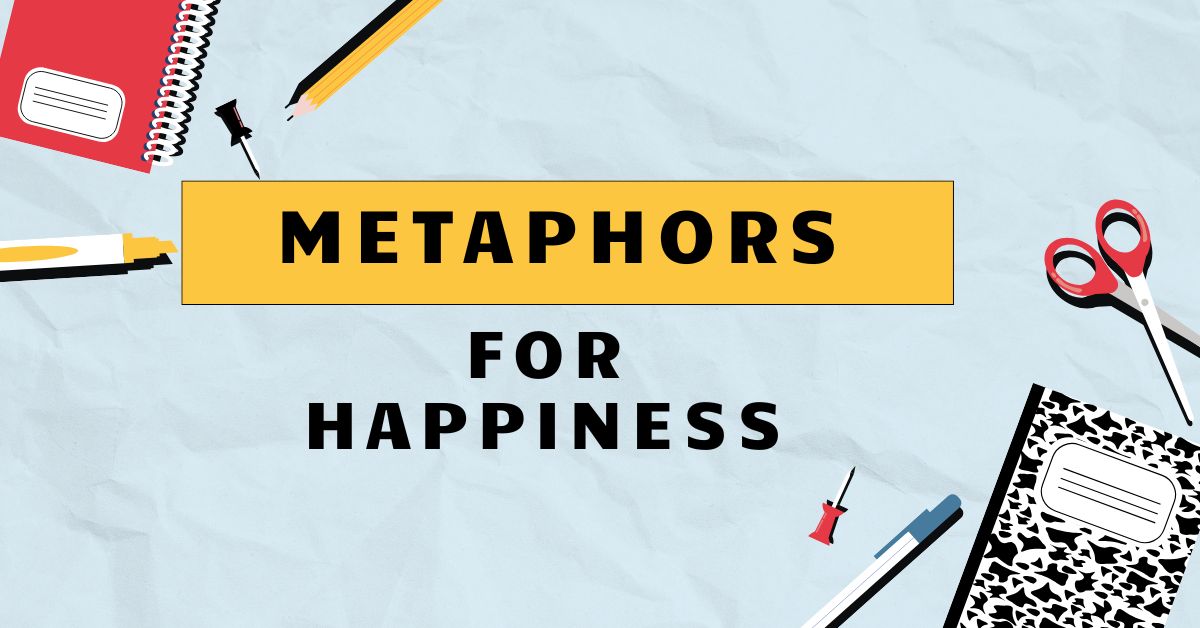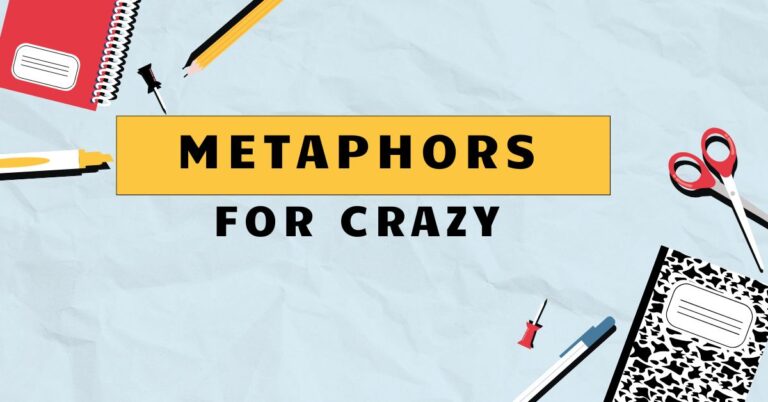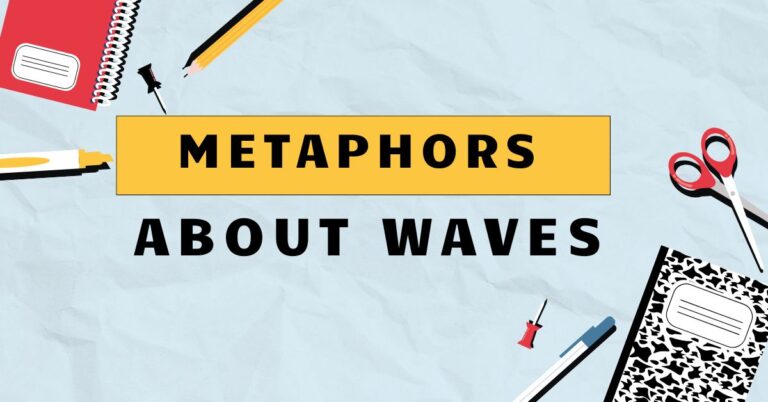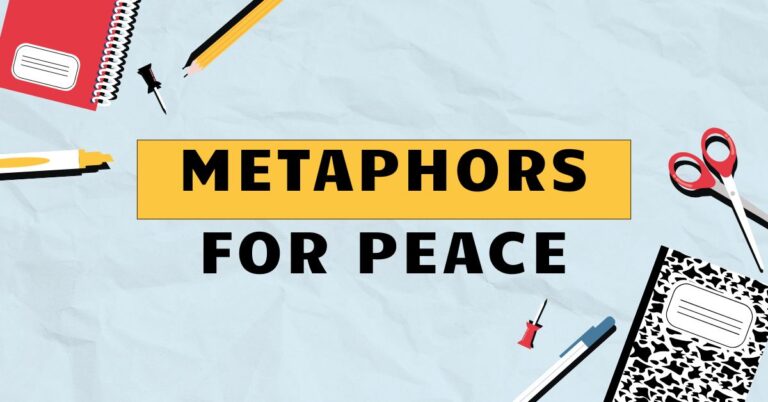41 Metaphors for Happiness: A Comprehensive Guide
Understanding metaphors for happiness enriches our comprehension of this complex emotion and enhances our ability to express it vividly. Metaphors, by their very nature, allow us to transfer qualities from one domain to another, providing a deeper and more nuanced understanding of abstract concepts like happiness.
This guide explores various metaphors used to describe happiness, their structural elements, and how to use them effectively in English. This article benefits English language learners, writers, and anyone interested in improving their understanding and expression of happiness through figurative language.
Table of Contents
- Introduction
- Definition of Metaphor and Its Role in Describing Happiness
- Structural Breakdown of Happiness Metaphors
- Types of Happiness Metaphors
- Examples of Happiness Metaphors
- Usage Rules for Happiness Metaphors
- Common Mistakes When Using Happiness Metaphors
- Practice Exercises
- Advanced Topics in Happiness Metaphors
- Frequently Asked Questions
- Conclusion
Definition of Metaphor and Its Role in Describing Happiness
Ametaphoris a figure of speech in which a word or phrase is applied to an object or action to which it is not literally applicable. It’s a way of describing something by comparing it to something else, suggesting a resemblance or shared quality.
Unlike similes, which use “like” or “as” to make a comparison, metaphors directly equate two unlike things. The power of metaphor lies in its ability to create vivid imagery and deeper understanding by transferring qualities from one concept to another.
In the context of happiness, metaphors are invaluable because happiness itself is an abstract emotion. It’s not something tangible that can be directly observed or measured.
Therefore, we rely on metaphors to make it more concrete and relatable. By comparing happiness to things we can understand through our senses – like light, warmth, or sweetness – we can better grasp its essence and communicate it more effectively.
Metaphors allow us to convey the intensity, duration, and even the subtleties of happiness in ways that literal language often cannot.
The function of metaphors extends beyond mere decoration of language. They shape our understanding and perception of the world.
When we say “happiness is a warm blanket,” we’re not just using a poetic expression; we’re suggesting that happiness provides comfort, security, and a sense of well-being, just like a warm blanket would. This metaphorical understanding influences how we seek, experience, and value happiness in our lives.
Structural Breakdown of Happiness Metaphors
A metaphor typically consists of two main elements: thetenorand thevehicle. The tenor is the subject being described (in this case, happiness), and the vehicle is the object or concept to which the tenor is being compared.
The link between the tenor and the vehicle is the shared quality or characteristic that makes the metaphor meaningful.
Consider the metaphor “Happiness is a ray of sunshine.” Here:
- Tenor: Happiness
- Vehicle: Ray of sunshine
- Shared Quality: Brightness, warmth, positivity, and the ability to dispel darkness.
The effectiveness of a metaphor hinges on the clarity and relevance of the shared quality. A strong metaphor resonates with the audience because the connection between the tenor and the vehicle is easily understood and evokes a specific feeling or image.
A weak metaphor, on the other hand, may be confusing or fail to convey the intended meaning.
Metaphors can also be extended, meaning they can be developed over several sentences or even paragraphs. This allows for a more detailed and nuanced exploration of the relationship between the tenor and the vehicle.
For example, instead of simply saying “Happiness is a garden,” one could elaborate on the metaphor by describing the various flowers (aspects of happiness), the gardener (the individual cultivating happiness), and the overall beauty and tranquility of the garden.
Types of Happiness Metaphors
Happiness metaphors can be broadly categorized based on the sensory experiences or concepts they draw upon. These categories include light and brightness, warmth and comfort, movement and elevation, sweetness and flavor, and growth and flourishing.
Light and Brightness
These metaphors associate happiness with light, radiance, and the absence of darkness. They emphasize the positive, illuminating, and uplifting aspects of happiness.
Examples include: “Happiness is sunshine,” “Happiness is a bright star,” and “Happiness is a beacon of hope.”
Warmth and Comfort
These metaphors connect happiness with feelings of coziness, security, and contentment. They highlight the comforting and soothing nature of happiness.
Examples include: “Happiness is a warm blanket,” “Happiness is a crackling fire,” and “Happiness is a gentle embrace.”
Movement and Elevation
These metaphors describe happiness as a feeling of being lifted up, moving forward, or soaring above challenges. They emphasize the exhilarating and liberating aspects of happiness.
Examples include: “Happiness is a soaring bird,” “Happiness is a gentle breeze carrying you forward,” and “Happiness is climbing a mountain and reaching the summit.”
Sweetness and Flavor
These metaphors relate happiness to pleasurable tastes and aromas. They highlight the delightful and satisfying nature of happiness.
Examples include: “Happiness is a sweet melody,” “Happiness is a sugary treat,” and “Happiness is a delicious aroma filling the air.”
Growth and Flourishing
These metaphors depict happiness as a state of growth, development, and abundance. They emphasize the nurturing and life-affirming qualities of happiness.
Examples include: “Happiness is a blooming flower,” “Happiness is a tree bearing fruit,” and “Happiness is a garden in full bloom.”
Examples of Happiness Metaphors
The following tables provide various examples of metaphors for happiness, categorized by type. Each example is designed to illustrate the different ways happiness can be expressed through figurative language.
The tables below provide a comprehensive overview of common and creative metaphors for happiness.
Table 1: Light and Brightness Metaphors for Happiness
This table showcases metaphors that equate happiness with various forms of light and brightness, emphasizing its illuminating and positive aspects.
| Metaphor | Explanation |
|---|---|
| Happiness is sunshine. | Happiness brings warmth and light into one’s life, similar to the sun. |
| Happiness is a bright star. | Happiness shines brightly, guiding and inspiring others. |
| Happiness is a beacon of hope. | Happiness provides guidance and reassurance during difficult times. |
| Happiness is a sunny disposition. | A cheerful and optimistic outlook is a form of happiness. |
| Happiness is a ray of hope in the darkness. | Even a small amount of happiness can alleviate despair. |
| Her smile was pure sunshine. | Her smile radiated joy and positivity. |
| His laughter lit up the room. | His laughter brought joy and energy to the environment. |
| Joy illuminated her face. | Happiness made her face glow with delight. |
| Contentment shone in his eyes. | His eyes reflected a deep sense of satisfaction. |
| Their happiness was a radiant dawn. | Their happiness marked a new and promising beginning. |
| A bright future stretched before them, filled with happiness. | Their future was full of promise and joy. |
| Her joy was like a sunbeam dancing on the water. | Her joy was bright, playful, and uplifting. |
| His spirit shone with inner happiness. | He possessed a deep and genuine sense of joy. |
| Their love was a luminous star in the night sky. | Their love provided guidance and inspiration. |
| The child’s laughter was a sparkling light. | The child’s laughter was pure, innocent, and joyful. |
| Happiness is the light at the end of the tunnel. | Happiness is the reward after overcoming challenges. |
| Her success was a shining example to others. | Her success inspired and motivated those around her. |
| His kindness was a bright spot in a difficult day. | His kindness brought a moment of joy and relief. |
| Their friendship was a source of constant light. | Their friendship provided continuous support and happiness. |
| Happiness is like a lighthouse guiding you home. | Happiness provides direction and safety in life. |
| Her eyes sparkled with happiness. | Her eyes showed her intense joy and excitement. |
| He had a sunny outlook on life. | He always looked at the positive side of things. |
| Their love was a beacon in the storm. | Their love provided hope and stability during difficult times. |
Table 2: Warmth and Comfort Metaphors for Happiness
This table presents metaphors that associate happiness with feelings of warmth, comfort, and security, highlighting its soothing and comforting qualities.
| Metaphor | Explanation |
|---|---|
| Happiness is a warm blanket. | Happiness provides comfort and security. |
| Happiness is a crackling fire. | Happiness brings warmth and a sense of coziness. |
| Happiness is a gentle embrace. | Happiness offers affection and reassurance. |
| His smile was like a warm hug. | His smile was comforting and welcoming. |
| Her voice was a soothing balm to his soul. | Her voice brought him peace and comfort. |
| Their love was a cozy haven from the storm. | Their love provided a safe and comforting refuge. |
| Friendship is a warm cup of tea on a cold day. | Friendship offers comfort and warmth. |
| Contentment settled over her like a soft blanket. | She felt a deep sense of peace and comfort. |
| The memories of their time together were a warm fire in his heart. | The memories brought him comfort and joy. |
| Her laughter was like a warm ray of sunshine on his face. | Her laughter brought him joy and warmth. |
| His presence was a comforting anchor in her life. | He provided stability and comfort. |
| Their bond was a warm and unbreakable chain. | Their connection was strong and comforting. |
| Happiness is like a purring cat on your lap. | Happiness is comforting and peaceful. |
| A mother’s love is a warm and safe harbor. | A mother’s love provides security and comfort. |
| His words were a gentle caress to her heart. | His words were comforting and kind. |
| Their home was a warm and inviting sanctuary. | Their home provided comfort and peace. |
| Happiness is a peaceful, crackling fire on a cold winter’s night. | Happiness brings comfort and warmth during difficult times. |
| Her smile was a warm and comforting light. | Her smile radiated warmth and kindness. |
| Their friendship was a constant source of warmth and support. | Their friendship provided continuous comfort and encouragement. |
| His love enveloped her like a warm blanket. | His love provided her with comfort and security. |
| The feeling of belonging was a warm and welcome embrace. | Feeling accepted brought comfort and joy. |
| Their laughter filled the room like a warm, comforting fire. | Their laughter created a cozy and joyful atmosphere. |
| Her kind words were a warm balm to his wounded spirit. | Her kind words provided comfort and healing. |
Table 3: Movement and Elevation Metaphors for Happiness
This table lists metaphors that describe happiness as a feeling of movement, elevation, or progress, highlighting its exhilarating and liberating qualities.
| Metaphor | Explanation |
|---|---|
| Happiness is a soaring bird. | Happiness provides a sense of freedom and elevation. |
| Happiness is a gentle breeze carrying you forward. | Happiness propels you forward with ease and grace. |
| Happiness is climbing a mountain and reaching the summit. | Happiness is the reward of achieving a challenging goal. |
| Her spirits lifted like a balloon. | She felt lighter and more joyful. |
| He floated on a cloud of happiness. | He felt euphoric and carefree. |
| Their joy took flight and soared through the air. | Their happiness was unrestrained and uplifting. |
| Her heart danced with excitement. | She felt a surge of joy and anticipation. |
| His dreams took wing and carried him to new heights. | His dreams inspired him to achieve great things. |
| Their love propelled them forward. | Their love motivated them to move towards their goals. |
| Her optimism was like a rising tide. | Her optimism grew stronger and more powerful. |
| His laughter bounded through the room. | His laughter filled the space with joy and energy. |
| Their spirits rose with each passing day. | Their happiness increased over time. |
| Happiness is like a roller coaster, full of ups and downs. | Happiness can be exhilarating and unpredictable. |
| Their success was a springboard to greater achievements. | Their success launched them towards bigger opportunities. |
| Her ambition soared like an eagle. | Her ambition was powerful and far-reaching. |
| Their future stretched before them like an open road. | Their future was full of possibilities and potential. |
| Happiness is a journey, not a destination. | The process of finding happiness is more important than the end result. |
| Her confidence grew with each step she took. | Her confidence increased as she progressed. |
| Their dreams took flight and carried them to faraway lands. | Their dreams inspired them to explore new horizons. |
| His enthusiasm was infectious, spreading like wildfire. | His enthusiasm quickly spread to others. |
| Their joy bubbled up from within. | Their happiness came from deep inside. |
| She felt like she was walking on air. | She felt incredibly happy and lighthearted. |
| Their love story took off like a rocket. | Their love story began quickly and intensely. |
Table 4: Sweetness and Flavor Metaphors for Happiness
This table provides metaphors that relate happiness to pleasant tastes and aromas, highlighting its delightful and satisfying nature.
| Metaphor | Explanation |
|---|---|
| Happiness is a sweet melody. | Happiness is pleasing and harmonious to the senses. |
| Happiness is a sugary treat. | Happiness is delightful and satisfying. |
| Happiness is a delicious aroma filling the air. | Happiness is pleasant and invigorating. |
| Their laughter was like sweet music to his ears. | Their laughter was joyful and pleasing. |
| Her smile was as sweet as honey. | Her smile was delightful and charming. |
| The taste of success was sweet in his mouth. | Achieving his goals brought him great satisfaction. |
| Their love was like a fine wine, growing richer with age. | Their love matured and improved over time. |
| Contentment was like a warm, comforting soup on a cold day. | Contentment provided comfort and satisfaction. |
| The memories of their time together were like a sweet dessert. | The memories brought them joy and pleasure. |
| Her words were like a spoonful of sugar, helping the medicine go down. | Her words made difficult situations easier to handle. |
| His presence was like a refreshing breeze on a hot day. | His presence was invigorating and comforting. |
| Their friendship was like a well-aged cheese, complex and satisfying. | Their friendship was deep and fulfilling. |
| Happiness is like a perfectly ripe fruit. | Happiness is satisfying and enjoyable. |
| A mother’s love is like a warm, freshly baked pie. | A mother’s love is comforting and nurturing. |
| His jokes were like a sprinkle of salt, adding flavor to life. | His jokes made life more interesting and enjoyable. |
| Their home was like a cozy and welcoming bistro. | Their home provided comfort and warmth. |
| Happiness is a cup of hot chocolate on a cold winter’s day. | Happiness brings warmth and comfort during difficult times. |
| Her smile was a sweet and delightful treat. | Her smile radiated joy and kindness. |
| Their friendship was a constant source of sweetness in their lives. | Their friendship provided continuous joy and pleasure. |
| His love enveloped her like a rich, decadent chocolate. | His love provided her with comfort and indulgence. |
| The feeling of accomplishment was a sweet and satisfying victory. | Achieving goals brought comfort and joy. |
| Their laughter filled the room like a sweet, melodic symphony. | Their laughter created a joyful atmosphere. |
| Her kind words were a sweet balm to his wounded spirit. | Her kind words provided comfort and healing. |
Table 5: Growth and Flourishing Metaphors for Happiness
This table presents metaphors that depict happiness as a state of growth, development, and abundance, emphasizing its nurturing and life-affirming qualities.
| Metaphor | Explanation |
|---|---|
| Happiness is a blooming flower. | Happiness is beautiful and full of life. |
| Happiness is a tree bearing fruit. | Happiness is productive and rewarding. |
| Happiness is a garden in full bloom. | Happiness is diverse and abundant. |
| Her spirit blossomed with joy. | She felt a surge of happiness and growth. |
| He thrived in the atmosphere of love and support. | He flourished in a nurturing environment. |
| Their love grew stronger with each passing year. | Their love became more profound and resilient. |
| Her dreams took root and began to flourish. | Her dreams started to grow and develop. |
| Contentment settled over her like a fertile field. | She felt a deep sense of peace and fulfillment. |
| The memories of their time together were like seeds of happiness. | The memories continued to bring them joy and growth. |
| Her words were like water, nourishing his soul. | Her words helped him grow and develop. |
| His presence was like sunshine, helping her to blossom. | His presence encouraged her growth and happiness. |
| Their friendship was like a strong oak tree, providing shelter and support. | Their friendship was reliable and nurturing. |
| Happiness is like a seed that grows into a beautiful plant. | Happiness develops over time with care and attention. |
| A mother’s love is like a nurturing garden, helping her children thrive. | A mother’s love provides the support needed for growth. |
| His ideas were like seeds, planted in fertile ground, waiting to sprout. | His ideas had the potential to grow and develop. |
| Their home was like a greenhouse, fostering growth and creativity. | Their home encouraged development and innovation. |
| Happiness is like a well-tended garden, requiring constant care and attention. | Happiness needs continued effort to maintain. |
| Her smile was a blossoming expression of joy. | Her smile radiated happiness and growth. |
| Their friendship was a constant source of growth and inspiration. | Their friendship provided continuous encouragement. |
| His love enveloped her like a nurturing embrace. | His love provided her with comfort and support. |
| The feeling of success was like a tree bearing fruit. | Achieving goals brought comfort and joy. |
| Their laughter filled the room like the sound of a lively spring. | Their laughter created a joyful and vibrant atmosphere. |
| Her kind words were a fertile ground for his dreams. | Her kind words provided support for his ambitions. |
Usage Rules for Happiness Metaphors
Using metaphors effectively requires attention to several key rules. First, ensure therelevanceof the comparison.
The vehicle should have a clear and logical connection to the tenor. Second, maintainconsistencywithin the metaphor.
Avoid mixing metaphors that create conflicting or confusing images. Third, consider youraudience.
Choose metaphors that are appropriate for their cultural background and level of understanding. Fourth, avoidclichés.
Overused metaphors can lose their impact and sound unoriginal. Strive to create fresh and imaginative comparisons.
Furthermore, be mindful of thecontextin which you are using the metaphor. A metaphor that works well in a poem may not be suitable for a formal essay.
Pay attention to the tone and style of your writing and choose metaphors that align with the overall message you are trying to convey.
Common Mistakes When Using Happiness Metaphors
One common mistake is usingmixed metaphors, where the comparison is confusing or illogical. For example, saying “Happiness is a warm blanket that sails through the sky” mixes the comforting image of a blanket with the soaring image of flight, creating a nonsensical picture.
A better approach would be to separate these ideas or find a more cohesive comparison.
Another frequent error is usingclichéd metaphorsthat lack originality. Phrases like “Happiness is sunshine” or “Happiness is a journey” have been used so often that they have lost their impact.
Try to think of more creative and unique ways to express happiness.
Incorrect: Happiness is a warm blanket that sails through the sky.
Correct: Happiness is a warm blanket on a cold night.
Correct: Happiness is a soaring kite on a breezy day.
Incorrect: Happiness is sunshine (overused cliché).
Correct: Happiness is a sudden burst of laughter in a quiet room.
Correct: Happiness is the feeling of sand between your toes on a summer day.
Practice Exercises
Test your understanding of happiness metaphors with these exercises. Identify the type of metaphor used in each sentence and explain its meaning.
Then, try creating your own metaphors for happiness using different categories.
Exercise 1: Identify the Type of Metaphor
For each sentence, identify whether the metaphor used falls into one of the following categories: Light and Brightness, Warmth and Comfort, Movement and Elevation, Sweetness and Flavor, or Growth and Flourishing.
| Question | Answer |
|---|---|
| 1. Her smile was as sweet as honey. | Sweetness and Flavor |
| 2. Happiness is a soaring bird. | Movement and Elevation |
| 3. Happiness is a warm blanket on a cold night. | Warmth and Comfort |
| 4. Their love grew stronger with each passing year. | Growth and Flourishing |
| 5. Joy illuminated her face. | Light and Brightness |
| 6. Happiness is a delicious aroma filling the air. | Sweetness and Flavor |
| 7. His spirits lifted like a balloon. | Movement and Elevation |
| 8. Happiness is a beacon of hope. | Light and Brightness |
| 9. Contentment settled over her like a soft blanket. | Warmth and Comfort |
| 10. Happiness is a blooming flower. | Growth and Flourishing |
Exercise 2: Create Your Own Metaphors
Create your own metaphors for happiness using each of the following categories. Try to be creative and original.
| Category | Your Metaphor |
|---|---|
| Light and Brightness | Happiness is the first ray of sunlight after a long night. |
| Warmth and Comfort | Happiness is a cup of hot cocoa by the fireplace. |
| Movement and Elevation | Happiness is a swing set, pushing you higher and higher. |
| Sweetness and Flavor | Happiness is the taste of fresh-baked cookies. |
| Growth and Flourishing | Happiness is a sapling reaching for the sky. |
| Light and Brightness | Happiness is the sparkle in a child’s eyes. |
| Warmth and Comfort | Happiness is a mother’s gentle touch. |
| Movement and Elevation | Happiness is a gentle dance in the rain. |
| Sweetness and Flavor | Happiness is the aroma of freshly brewed coffee in the morning. |
| Growth and Flourishing | Happiness is a new leaf unfurling in springtime. |
Advanced Topics in Happiness Metaphors
For advanced learners, exploring thecultural variationsin happiness metaphors can be insightful. Different cultures may emphasize different aspects of happiness and use different imagery to describe it.
For example, some cultures may associate happiness with community and harmony, while others may focus on individual achievement and personal fulfillment. Understanding these cultural nuances can enhance your ability to communicate effectively with people from diverse backgrounds.
Another advanced topic is the use ofmixed metaphorsfor stylistic effect. While generally discouraged, skilled writers can sometimes use mixed metaphors intentionally to create a jarring or surreal effect.
This technique requires a deep understanding of metaphor and a careful consideration of the intended audience.
Frequently Asked Questions
- What is the difference between a metaphor and a simile?
- Why are metaphors useful for describing abstract concepts like happiness?
- How can I avoid using clichéd metaphors?
- What should I do if I accidentally use a mixed metaphor?
- Can metaphors be used in formal writing?
- How can I improve my ability to understand and use metaphors?
- Are there any specific cultural considerations when using metaphors for happiness?
- How do I know if a metaphor is effective?
- Can a simile be turned into a metaphor, and vice versa?
- What role does context play in understanding metaphors for happiness?
A metaphor directly equates two unlike things, while a simile uses “like” or “as” to make a comparison. For example, “Happiness is sunshine” is a metaphor, while “Happiness is like sunshine” is a simile.
Similes are generally considered less forceful than metaphors because they acknowledge the difference between the two things being compared, while metaphors assert a direct equivalence.
Metaphors make abstract concepts more concrete and relatable by comparing them to tangible things that we can understand through our senses. This allows us to grasp the essence of the concept and communicate it more effectively.
To avoid clichés, try to think of fresh and original comparisons that haven’t been used extensively. Consider the specific qualities of happiness that you want to emphasize and brainstorm new ways to express them.
Reading widely and exposing yourself to different forms of creative writing can also help you develop a more imaginative approach to metaphor.
If you realize that you’ve used a mixed metaphor, revise the sentence to create a more cohesive and logical comparison. You can either choose a different vehicle that aligns better with the tenor or separate the conflicting images into distinct metaphors.
Yes, metaphors can be used in formal writing, but they should be used judiciously and with careful consideration of the audience and context. Avoid overly flowery or sentimental metaphors that may detract from the overall tone and purpose of the writing.
Choose metaphors that are clear, concise, and relevant to the topic at hand.
Practice is key. Read widely and pay attention to the metaphors that other writers use.
Try to analyze the structure and meaning of these metaphors and consider why they are effective. Also, make a conscious effort to incorporate metaphors into your own writing and speaking.
The more you practice, the more comfortable and confident you will become.
Yes, different cultures may have different associations with certain images or concepts. What is considered a positive and uplifting metaphor in one culture may be viewed differently in another.
It’s important to be aware of these cultural nuances and choose metaphors that are appropriate for your intended audience. Researching cultural attitudes towards happiness and figurative language can be helpful.
An effective metaphor is clear, relevant, and evocative. It should resonate with the audience and create a vivid image or feeling.
If a metaphor is confusing, forced, or doesn’t convey the intended meaning, it’s likely not effective and should be revised.
Yes, a simile can often be turned into a metaphor by removing the words “like” or “as” and directly equating the two things being compared. Conversely, a metaphor can be turned into a simile by adding “like” or “as” to soften the comparison.
Context is crucial for understanding metaphors. The surrounding sentences, the overall tone of the writing, and the cultural background of the audience all contribute to the interpretation of a metaphor.
A metaphor that is clear in one context may be confusing or inappropriate in another.
Conclusion
Mastering metaphors for happiness enhances our ability to express and understand this complex emotion. By grasping the structural elements and different categories of these metaphors, we can use them effectively in our writing and communication.
Remember to focus on relevance, consistency, and originality, and to avoid common mistakes like mixed metaphors and clichés. Practicing regularly and paying attention to cultural nuances will further refine your skills.
The key takeaway is that metaphors are powerful tools for conveying abstract ideas. They allow us to connect with others on a deeper level by creating vivid imagery and shared understanding.
So, embrace the power of metaphor and use it to illuminate the many facets of happiness in your life and in your writing. By continuously exploring and experimenting with figurative language, you can unlock new and creative ways to express the joy and fulfillment that happiness brings.







